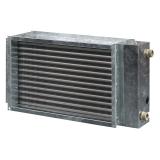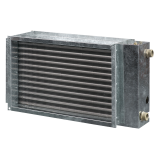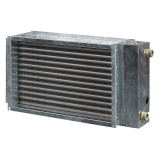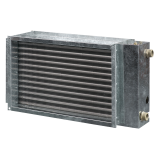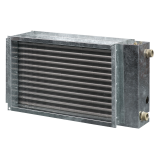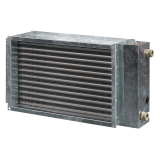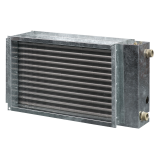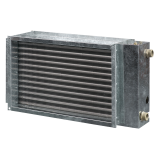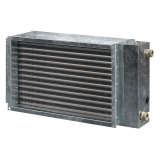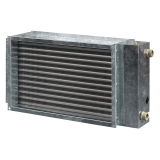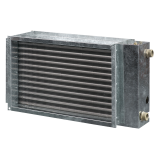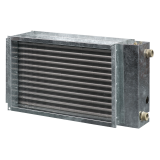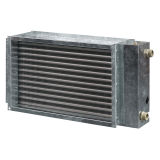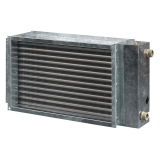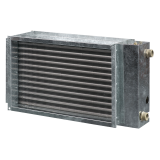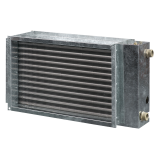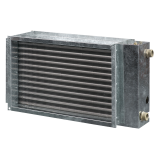Blauberg WKH 70x40-2
- Description
- Characteristics
- Downloads
- Designation key
- Dimensions
- Air pressure loss
- Calculation diagram
| FEATURES
For warming up of supply air in ventilation systems installed in various premises. Suitable for installation in supply or air handling units to warm up the supply air flow. For indoor use only if water serves as a heat carrier. For outdoor Features use antifreezing mixture (ethylene glycol solution). Compatible with 400×200 up to 1000×500 mm rectangular air ducts. DESIGNGalvanized steel case. Copper pipe manifold. Heat exchange surface made of aluminium plates. Equipped with a nipple for the system deaeration. Outlet header is equipped with a spigot for installation of an immersion temperature sensor or freezing protection mechanism. Available in two, three- or four-row tube modifications. Suitable for operation at maximum operating pressure 1.6 MPa (16 bar) and maximum transported air temperature +100 °C. |
MOUNTING
Fixing to rectangular ducts with flange connection. Any mounting position that ensures the heater deaeration. Install a filter upstream to the heater to protect heating elements against dirt ingress. Install the heater in front or behind the fan. In case of mounting behind the fan ensure the distance no less than 1–1.5 m for air flow stabilization and keep the maximum permissible air temperature inside the fan. Connect the heater on counter-flow basis, otherwise its capacity drops by 5–15 %. All the nomographic charts are rated for counter-flow connection. For correct and safe heater operation an automatic control and protection system is recommended, including the following functions:
|
|
|
Connection against air flow |
Connection along air flow |
| Parameter | WKH 70x40-2 | Measurement unit |
|---|---|---|
| Connected air duct size | 700х400 | mm |
| Number of water coil rows | 2 | - |
| Weight | 27.8 | kg |
| Casing material | galvanized steel | - |
| Air duct | for rectangular air ducts | - |
| Series | Flange size (WxH) [cm] | Number of water (glycol) coil rows | |
| WKH | 40x20; 50x25; 50x30; 60x30; 60x35; 70x40; 80x50; 90x50; 100x50 | — | 2; 3; 4 |
/WKH-rectangular-dimensions-300.png)
| Model | Overall dimensions [mm] | |||||||||||
| B | B1 | B2 | B3 | H | H1 | H2 | H3 | L | L1 | L2 | K | |
| WKH 70x40-2 | 700 | 720 | 740 | 895 | 400 | 420 | 440 | 350 | 200 | 36 | 47 | G 1” |
/WKH-rectangular-pressure-loss-350-EN-2.png)
/graphs/WKH-70x40-2-graph-1000-EN.png)
|
How to use water heater diagrams. System Parameters: Air flow = 4500 m³/h. Outside air temperature = -10 °C. Water temperature (in/out) = +90/+70 °C. The air flow is 950 m³/h and the air speed in the heater is 4.45 m/s ①. |
||
| To calculate the maximum air temperature find the intersection point of the air flow line ① with the rated outer temperature shown in blue line (e.g., -10 °C) and draw the line ② to the left until it crosses the water in/out temperature curve (e.g., +90/+70). From this point draw a vertical line to the supply air temperature downstream of the heater (+24 °C) ③. To calculate the heater power find the intersection point of the air flow ① with the rated winter temperature shown in red line (e.g., -10 °C) and draw the line ④ to the right until it crosses the water in/out temperature curve (e.g., +90/+70). From this point draw a vertical line to the heater power axis (55.0 kW) ⑤. | To calculate the required water flow in the heater prolong this line ⑥ downwards to the water flow axis (0.68 l/s). To calculate the water pressure drop in the heater find the intersection point of the line ⑥ with the pressure loss curve and prolong the line ⑦ to the right on the water pressure drop axis (9.2 kPa). |

 Domestic fans
Domestic fans Industrial fans
Industrial fans Single-room air handling units with heat recovery
Single-room air handling units with heat recovery Air handling units
Air handling units  Smoke extraction and ventilation
Smoke extraction and ventilation Ventilation accessories
Ventilation accessories Ventilation ducts and fittings
Ventilation ducts and fittings Air distribution
Air distribution Measurement and control technology
Measurement and control technology Ventilation sets and vents
Ventilation sets and vents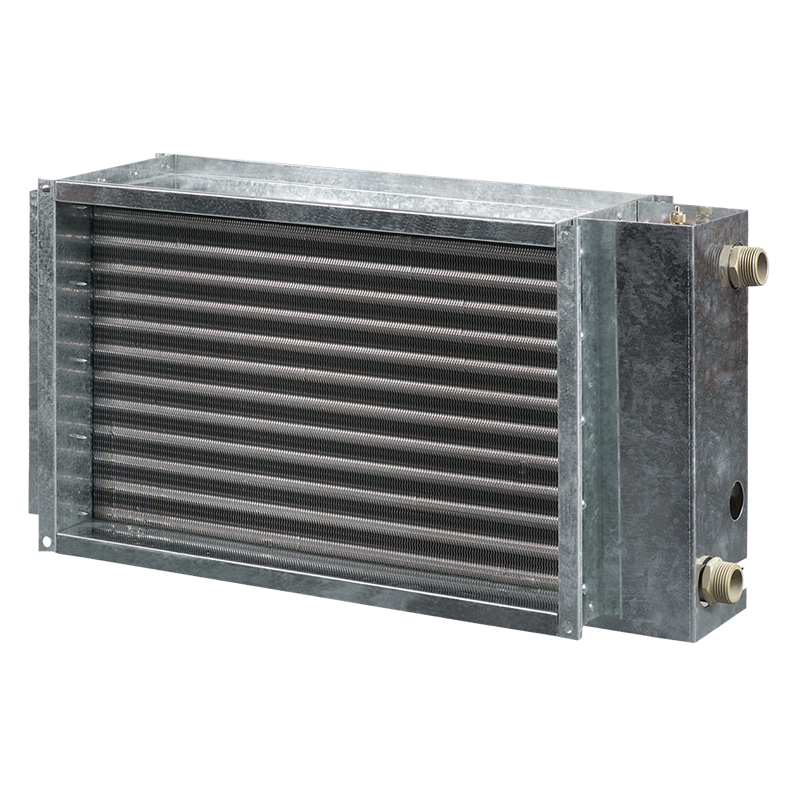


/WKH-rectangular-connection-against-air-flow-200.png)
/WKH-rectangular-connection-along-air-flow-200.png)
